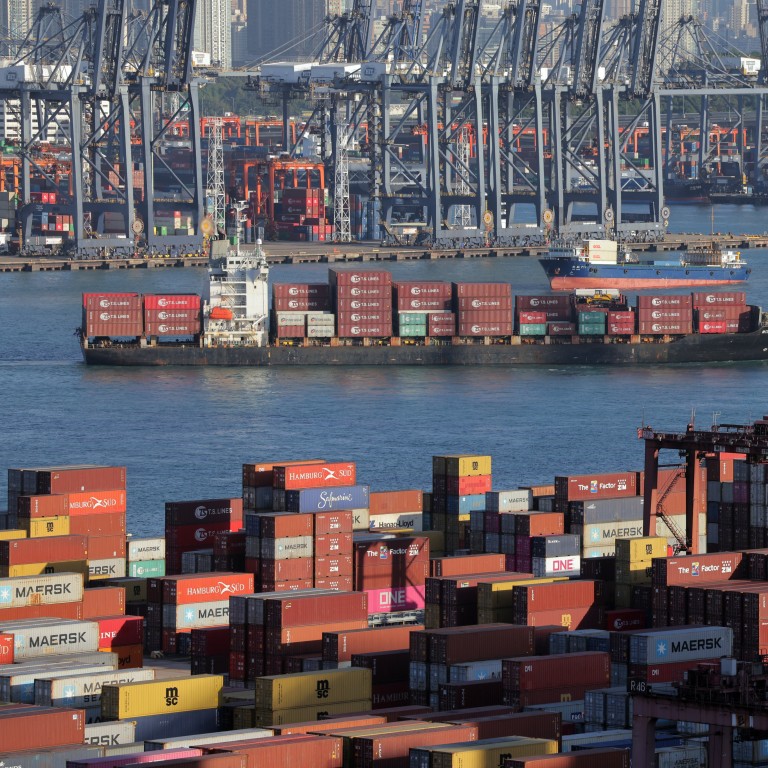
Hong Kong launches action plan to develop ports into leading international maritime centre
- Hong Kong is ‘well-positioned’ to become the world’s leading international maritime centre, secretary for transport and logistics Lam Sai-hung says
- The action plan lays out 10 strategies and 32 actions to lift Hong Kong’s status as an international maritime centre
The government has announced a plan to develop Hong Kong into a leading international maritime centre, and promote the sustainable development of the industry.
The plan addresses some of the challenges faced by Hong Kong’s maritime and ports industry, including declining cargo throughput and rising competition.
It comes amid a downtrend at the port of Hong Kong – container throughput has been in decline for about a decade, dropping from 23.1 million twenty-foot equivalent units (TEUs) in 2012 to 16.7 million TEUs last year. Strong competition from other ports in both China’s Greater Bay Area and Southeast Asia has coincided with high costs, constrained port operation areas and a shift in supply chain and trade flow patterns to the detriment of the facility.
“With its superior geographical location, unique institutional advantages, free economic system and rich experience of international business and trade, Hong Kong is well-positioned to become the world’s leading international maritime centre,” Lam Sai-hung, the secretary for transport and logistics, said at a media briefing during the launch of the plan.
As Hong Kong’s ports faces intensified regional competition, reduced cargo supplies and a weakening of their competitive advantages, the government needs to propose more measures to consolidate Hong Kong’s advantages, said Ryan Ip, the vice-president and co-head of research at the Our Hong Kong Foundation.
Hong Kong’s logistics sector eyes smart digital technology
“The government should consider the positioning of Hong Kong’s ports, strengthen division of labour and collaboration with other ports in the Greater Bay Area, integrate the comparative advantages of different ports, and avoid the overlap of resources, so as to enhance the overall competitiveness of the ports in the Greater Bay Area,” Ip added.
The government has put forward a series of actions to promote the development of the industry by enhancing the competitiveness of its ports, developing high value-added maritime services and strengthening the talent pool.
The plan lays out 10 strategies and 32 actions to lift Hong Kong’s status as an international maritime centre, including developing the city as a green shipping hub with zero carbon emissions, facilitating smart port development and promoting maritime digitalisation.
Lack of infrastructure ‘hindering projects to cut ships’ carbon emissions’
It also aims to enhance Hong Kong’s maritime influence through Greater Bay Area and international cooperation, as well as the exploration of further tax concessions to attract international maritime enterprise.
The maritime and port industry is an important component of Hong Kong’s economy, contributing about HK$111.8 billion (US$14.3 billion), or 4.1 per cent of the city’s gross domestic product (GDP), and about 78,400 jobs, or 2.1 per cent of total employment, according to the plan.

Currently, there are more than 1,100 port and maritime companies in Hong Kong providing a diverse range of services.
The city’s high value-added maritime services are bolstered by a robust and transparent legal framework, clear regulations and a business-friendly environment, according to the plan.
To maintain Hong Kong’s port business and promote the development of an international maritime centre, the government will make every effort to develop Hong Kong as a green and smart port, the plan says.
It “will holistically attract cargoes from around the world to make use of Hong Kong Port, and collectively tackle the challenges in relation to the zero-carbon emission target of the global maritime industry”.
With climate change being a top policy consideration, the maritime and port industry is facing stronger demand from various authorities to decarbonise, and customers are also expecting efforts from all industries in meeting zero-emission goals, according to the plan.
Greener shipping: why China will drive the industry’s adoption of wind power
“This action plan is a major document formulated by the Hong Kong government for the development of the maritime and port industry,” said deputy secretary for transport and logistics, Amy Chan.
“We will, in collaboration with stakeholders in the shipping and port industry, implement the actions outlined in the plan progressively to strive towards the goal of establishing Hong Kong as a leading international maritime centre.”
During his visit to Beijing on December 18, Chief Executive John Lee Ka-chiu received President Xi Jinping’s blessings to consolidate and boost Hong Kong’s role as an international financial, maritime and trade centre, according to a report from state news agency Xinhua.
Speaking at the opening ceremony of the World Maritime Merchants Forum on November 20, Lee said the plan “will enhance high-end maritime services, facilitate transformation towards zero emissions, promote smart and digital initiatives in the industry, and promote global exchanges”.
The city, as a “superconnector” and a “super value-adder”, will lead the way in driving the green transformation of the marine industry, Lee added.
The task force on maritime and port development strategy was announced in Financial Secretary Paul Chan Mo-po’s 2023 budget speech on February 22, and was established by the Transport and Logistics Bureau on April 19.

